What is Italian Ham?
Italian ham is a type of meat that is typically made from the hind leg of a pig or wild boar. The meat is then seasoned with salt, pepper, and other spices before being cured for several months.
The curing process not only adds flavor to the meat but also helps to preserve it. After curing, the ham can be sliced thinly and served as-is or used in recipes.
Italian ham has a long history dating back to ancient Rome when pigs were first domesticated. In those days, the hind legs of pigs were typically cured and smoked to preserve them.
Cured ham was also a popular item in medieval times. During this era, salt became increasingly available which made it easier to cure meat. This, combined with advances in smoking techniques, resulted in a boom in the popularity of cured meats like Italian ham.
Today, Italian ham is still made using traditional methods and is enjoyed by people all over the world.
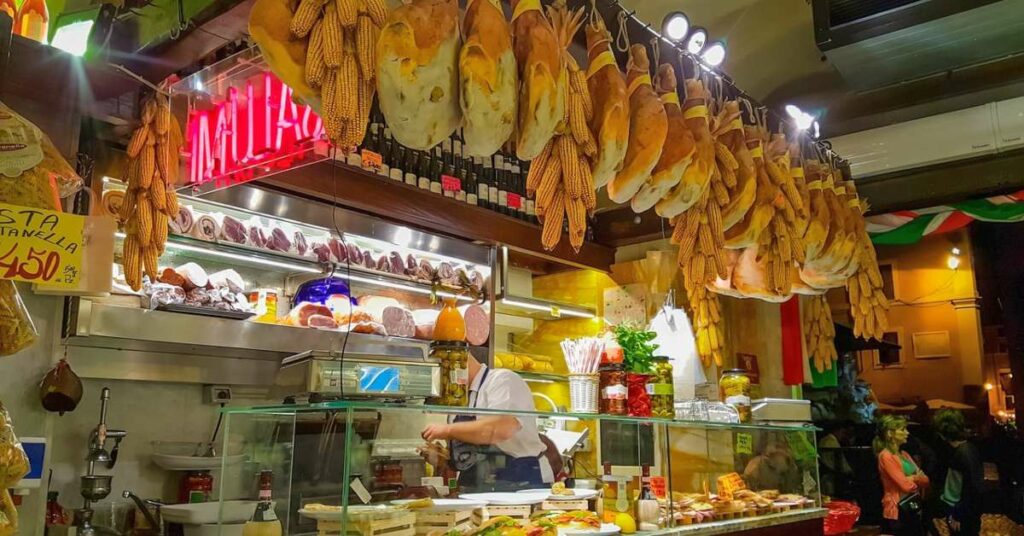
How Do You Say Ham in Italian?
In general, ham in Italian is called prosciutto. However, as we will see throughout this article, there are special variations and distinct types of Italian hams that have more specific names based on the type of pig used, the curing method, but mostly on the area of origin.
For example, Prosciutto di Parma is the most famous type of Italian ham, especially outside of Italy. However, if you are from Italy’s northern region of Friuli Venezia Giulia, you probably prefer Prosciutto di San Daniele.
Origins of Prosciutto
Prosciutto has a long history dating back to pre-Roman times. It is believed to have originated in Italy, where villagers used a dry-curing process to extend the shelf-life of pork legs. The word prosciutto translates as ham and is made from the hind legs of the pig.
There are two broad categories of prosciutto: prosciutto crudo, which is uncooked and cured, and prosciutto cotto, which is cooked.
Over the centuries, the tradition of making prosciutto was perfected, creating variations in different regions of Italy. For example, Prosciutto Toscano has been produced under strict laws and traditions since the 15th century. This type of prosciutto is now made exclusively with pigs born, bred, fattened, and slaughtered in Tuscany and is salted and air cured for 12-16 months.
Other types of prosciutto such as Prosciutto di Parma, Prosciutto di San Daniele, Prosciutto di Modena, Culatello, and Speck are also popular.
Let’s have a closer look at these different varieties of Italian hams.
Different Types of Italian Hams
Prosciutto di Parma
Parma ham is one of the most popular Italian cured meats outside of Italy and has been produced under the same diligent care since Roman times. It is a unique savory-sweet delight, with a complex flavor and creamy texture, expertly prepared by master salters.
The animals used in the production of this ham must meet very high-quality standards, raised in one of the 10 regions of northern and central Italy and fed with flour, cereals and Parmigiano Reggiano cheese whey, which contributes to its unique taste.
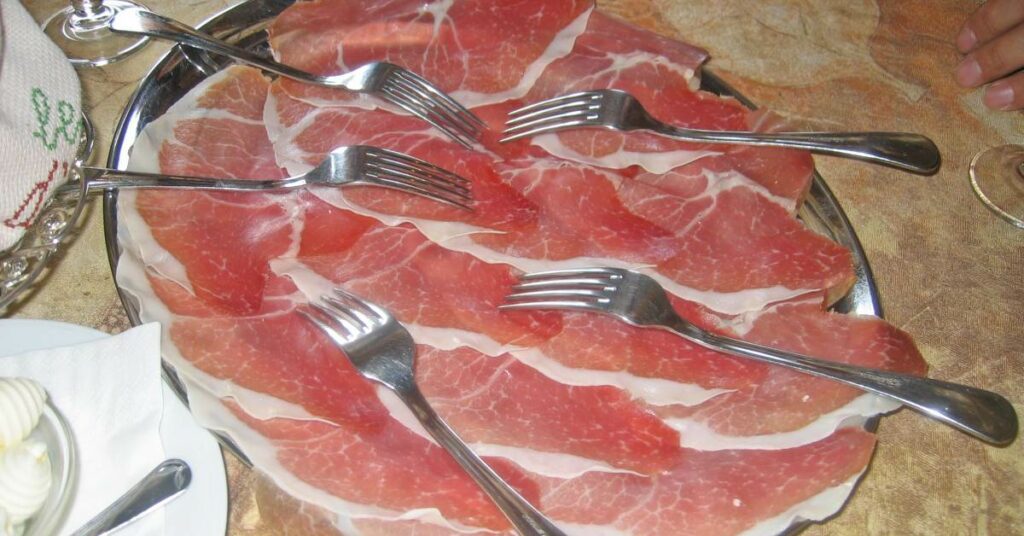
Prosciutto di San Daniele
San Daniele ham is a sweet and delicate ham produced in the north-west of Italy without the use of additives or impurities. It is usually produced with Duroc breed pigs, reared in one of the five territories in the north of the Italian peninsula where the climate is more suitable for curing hams.
Furthermore, the salting is carried out with a mixture of sea salt which creates a unique balance in taste.
Prosciutto di Norcia
Norcia ham is a typical specialty of the province of Perugia, in particular of the city of Norcia and the Valnerina.
There are two types of Prosciutto di Norcia, Tipico di Norcia, also known as Salato or Prosciutto di Montagna, which is aged for at least twelve months and has a saltier flavor, and L’Antico di Norcia, which is aged slowly in the cold, dry mountain air for two full years.
What makes Norcia ham unique is therefore its long maturation, which gives it an intense flavor and a much softer texture than other Italian hams.
Culatello
Culatello is a type of cured meat that is very popular in Italy, particularly in the province of Parma in the Emilia-Romagna region. It is made from the filet or loin of the hind leg of the pig and aged in a beef or hog’s bladder, which prevents spoilage and contamination.
Culatello di Zibello possesses PDO status, which grants it a unique flavor and delicate texture. This cured meat has been made in the same area of Italy since medieval times, and only eight local villages within the Zibello area can produce it.
Culatello has a rich, intense flavor and a deep red color, making it one of Italy’s most prized hams. The traditional method of curing culatello involves seasoning it with salt, black pepper, and garlic before wrapping it in a clean pig’s bladder, netting it, and hanging it in a cold, wet cellar.
This process is aided by the fog of the nearby Po River, which helps maintain the cool, damp atmosphere necessary to create the special mold that gives culatello its unique flavor.
In terms of its culinary uses, culatello is primarily served as an appetizer, much like a salami or prosciutto. It is served thinly sliced with toast and is considered an ideal starter for Italian meals. Its delicate texture and bold flavor make it a favorite of Italian foodies, and its rarity makes it a highly sought-after delicacy.
Prosciutto di Modena
Modena ham is a cured meat that has ancient origins and dates back to the times of the Celts and Romans. Traditionally, this ham is produced in the hilly and flat areas along the Panaro river, up to an altitude of 900 meters, in the provinces of Modena, Bologna and Reggio Emilia.
During production, only the Large White, Landrance, and Duroc breeds are used, and all production techniques are highly detailed and regulated, with precise rules on the stall, tracking marks, demolding, salting and anointing. Modena ham has an intense aroma and a delicate, less salty flavor.
Prosciutto di Carpegna
Carpegna ham is a product of unique tradition in the Marche region, dating back to the 15th century. It is produced with pigs raised and slaughtered exclusively in the Marche, Lombardy and Emilia-Romagna regions, with a maturing process that lasts for a minimum of 13 months.
Its peculiarity is also given by the fact that, unlike other Italian hams, Prosciutto di Carpegna can be flavored with a blend of spices, such as pepper, garlic, rosemary and juniper, thus giving a unique and rich flavor to the product.
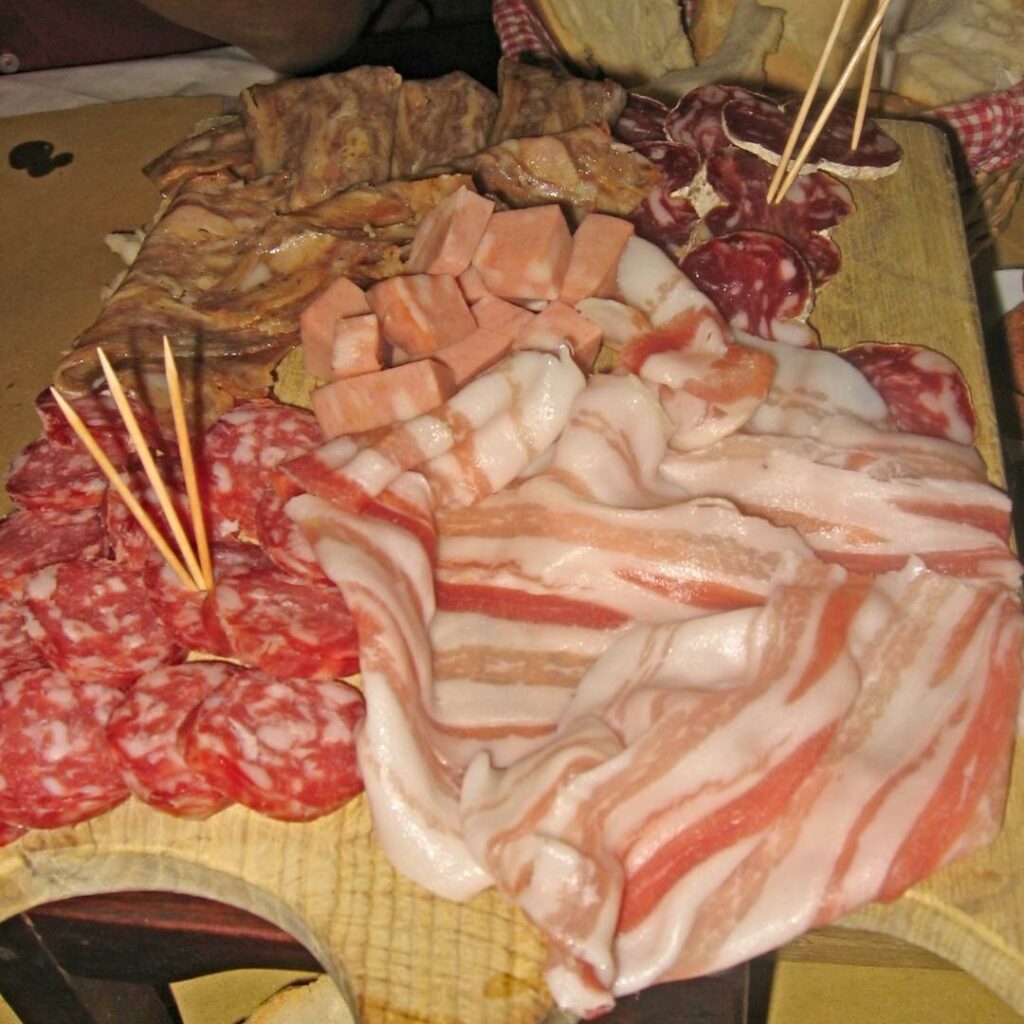
Salumi italiani
“Salumi Italiani” can roughly be translated as Italian cured meats, and can encompass a wide variety of culinary products. Types of Italian cured meats include, among others, Bresaola, Cacciatore, Capicola, Coppa, and Culatello.
Bresaola is a cut of air-dried beef originating from the Aosta Valley, characterized by a delicate aroma and a dark red color.
Cacciatore is a small, sweet and dry salami with a strong and spicy flavor.
Capicola is a pork salami made with marinated pork shoulder, flavored with chili pepper, salt and garlic.
Coppa is a form of ham produced with salted, flavored and dried pork shoulder or neck.
Culatello, originally from Parma, is one of the finest salted meats, produced with a cut of ham, salted, flavored and placed in a pig bladder.
Prosciutto vs Bresaola
The main difference between prosciutto and bresaola is the type of meat used.
Prosciutto is a type of Italian dry-cured ham, made from the hind leg of pork and cured with salt. It can come from a variety of regions, including Parma, Tuscany, San Daniele and Modena, and can be seasoned with herbs and spices for a unique flavor.
Bresaola, on the other hand, is an Italian air-dried beef, made from the top round of beef and salted, before being aged for several months. It is typically served thinly sliced, and has a deep, slightly sweet and salty flavor.
European Union Protected Designations of Origin for Italian Ham
Prosciutto crudo
There are several types of Italian cured ham that have the designation PDO (Protected Designation of Origin). It is a branding that guarantees that each phase of cured ham production is in line with the procedural provisions of the local Consortium which preserves the original recipe.
There are eight types of ham certified with the PDO brand: Prosciutto di Parma DOP, Crudo di Cuneo DOP, Prosciutto di Carpegna DOP, Prosciutto di Modena DOP, Prosciutto di San Daniele DOP, Prosciutto Toscano DOP, Prosciutto Veneto Berico-Euganeo DOP and Jambon De Bosses DOP from Val d’Aosta.
What factors to consider when buying Italian ham
Italian Ham: Quality and flavor
When it comes to buying Italian ham, there are a few quality and flavor considerations. When it comes to quality, it is important to look for authenticity and certification. The IGP (Indication of Geographic Protection) and DOP (Protected Designation of Origin) are two certifications that ensure the ham you are buying is the real deal.
In terms of flavor, there are a variety of hams to choose from. Prosciutto di Parma is the most well-known, with its thin slices and velvety, salty-sweet flavor, while Prosciutto di Carpegna, Tuscan Prosciutto Crudo, and Prosciutto di San Daniele all have their own unique flavors and aromas.
Italian Ham: Varieties and brands
Italian ham comes in a variety of different brands and varieties. These include the DOP-certified Prosciutto di Parma, which is made with meat from pigs raised in northern Italy and whose diet is based on chestnuts. This ham is soft in texture, with a slightly salty and less intense flavor than the Ibérico bellota hams, for example.
Other DOP-certified Italian hams include San Daniele ham (prosciutto di San Daniele), which is characterized by its rounded shape and minimal curing time of one year, and Prosciutto Toscano, which is cured with salt, rosemary, black pepper, and juniper.
There are also IGP-certified hams such as Prosciutto di Carpegna and Prosciutto di Norcia, and the smoked Speck Alto Adige, which has a unique flavor due to its smoking process.
Finally, there is the culatello, which is the juiciest part of the ham and is usually sold separately and at a higher price.
Italian Ham: Cotto or Crudo?
The main difference between Italian ham cooked and uncooked is that prosciutto crudo, or raw, cured ham, is made using the traditional method of drying pork legs to extend the meat supply during the winter months and is served uncooked.
Prosciutto cotto is not dry-cured, but rather cooked. Prosciutto crudo has a more complex flavor than prosciutto cotto due to the aging process, and there are several regional varieties of prosciutto crudo, each with its own degree of protected status from the Italian government.
In contrast, Prosciutto cotto is more widely available and is often served as an ingredient in Italian dishes. Both types of Italian ham can be eaten in slices as part of a charcuterie board or as an appetizer, but the flavor and texture of prosciutto crudo make it ideal for eating as is.
Italian Ham: Price and availability
When buying Italian ham, price and availability are two important considerations. Obviously, these prices vary according to seasons, and just general price fluctuations and inflation.
But just as an example, when buying imported Prosciutto di Parma in the U.S. from a grocery chain such as Whole Foods, you can expect to pay around $26 for sliced prosciutto in the deli. Or you can buy an entire leg on Amazon from about $249.
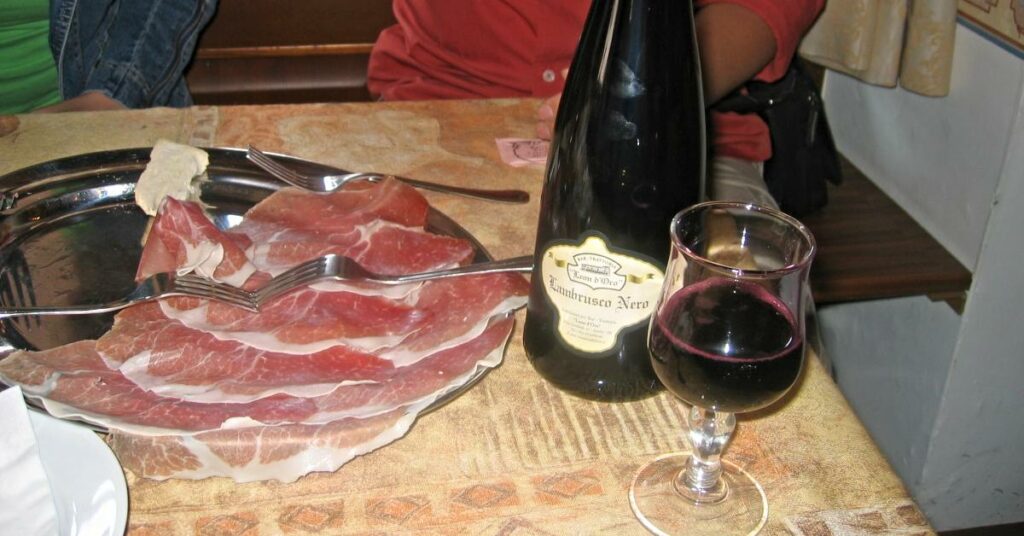
How to Eat Prosciutto
Selecting the Right Italian ham
When selecting an Italian ham, there are a few factors to consider. First, determine the region of origin. Each has its own type of pigs, unique curing techniques, and aging process, all of which impacts their flavor.
Also consider the source. Even if a quality Italian ham is obtained by a distributor, it doesn’t mean that they are storing and transporting it properly. If not held at the right temperature, it could lose its flavor or even spoil.
Finally, consider the price of the ham; some Italian hams can be quite expensive. If you’re planning to eat the ham “as-is” then you should be willing to pay more for it, as opposed to ham that you are using in a recipe.
Italian Ham Traditions and Customs
Eating prosciutto is a tradition deeply rooted in Italian culture and it is often consumed as part of a festive meal. It is usually served as an appetizer, or perhaps during an Italian aperitivo, often accompanied by fresh bread, olives, and cheese.
In various regions of Italy, certain customs and traditions are associated with eating prosciutto. In some regions, it is considered an auspicious sign to break the prosciutto with two hands, as it symbolizes sharing and unity. In other regions, it is custom to serve prosciutto with melon as a special treat.
Prosciutto is an important part of Italian culture, and its food traditions are deeply embedded in the country’s history. Prosciutto is a versatile food which can be enjoyed in a variety of ways, making it a staple of Italian meals.
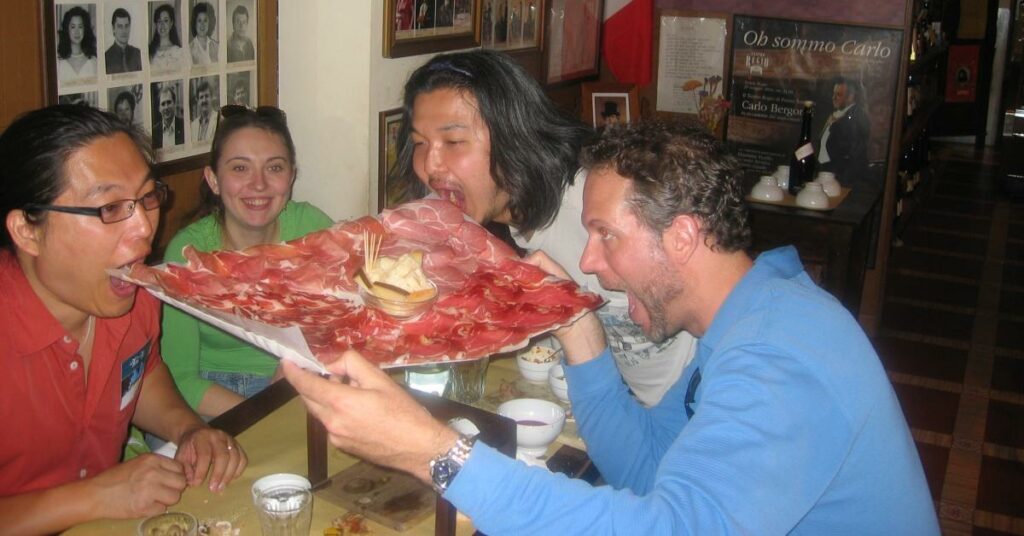
How to Prepare Italian Ham
Step 1: Begin with a fresh joint of Italian ham. Remove the fat and skin from the ham, then massage a mix of salt, pepper, lard, and flour into the meat.
Step 2: Hang the ham in a well-ventilated room for one day.
Step 3: Remove the ham from the room and salt it once a week for a month.
Step 4: After a month of salting, wash the ham off and dry it in a warm room.
Step 5: Grease the ham with a mixture of salt, lard, pepper, and flour and age it for months or years, depending on the type of ham.
How to Serve Italian Ham
Italian ham, such as Prosciutto, should be served at room temperature. Slice the ham very thin and arrange the slices on a large plate so that the slices can be spread out rather than piled up.
For an appetizer, you can top each slice with a fig, soft cheese, and small sage leaf. Wrapping prosciutto around a piece of melon is a classic dish, especially in the summer.
For a sandwich, serve the ham on a ciabatta roll with mozzarella, tomato, arugula, and a splash of olive oil. You can also add thin slices of Prosciutto to your favorite pizza for a savory flavor.
Prosciutto: Wine Pairing
Pairing prosciutto with Italian wine is a classic combination, and you can have a lot of fun with this, depending on which aspect of the Italian ham you want to compliment.
You can pair with saltiness of the prosciutto, so an off-dry white would be an excellent choice, like a Soave from region of Veneto in the north. Or you could appeal to the gamy aroma and choose a Malbech, also from the Veneto.
But the classic combination comes from Parma, of course, where they pair their Prosciutto di Parma with a dark-purple, bubbly Lambrusco. The gentle bubbles cleanse the palate while the tannins are mellowed by the fat of the ham.
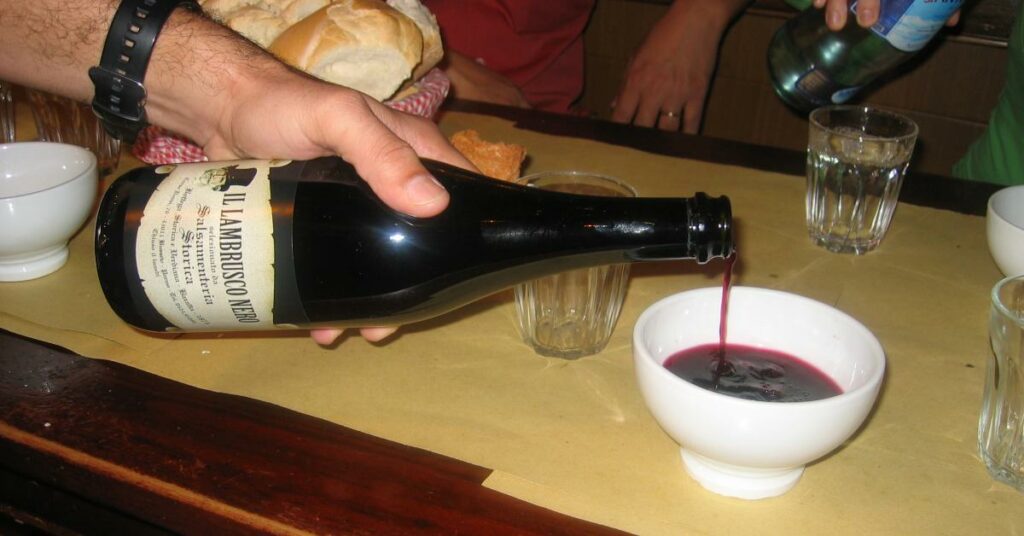
Prosciutto FAQs About Italian Ham
What is Italian ham?
Italian ham, otherwise known as Prosciutto, is a type of cured ham made from the hind legs of the pig. It is made by dry-curing the meat in sea salt, and then aging it for at least 400 days. The curing process gives Italian ham its distinctive deep, rich, and full-bodied flavor, as well as its delicate aroma and lively pinkish-red color.
How is Italian ham made?
The process of making authentic cured Italian ham starts with the choice of pork thighs, which are first hung in a well-ventilated room for a day or longer. After trimming the fat and hide, salt is massaged onto the meat weekly for approximately a month.
Once this is complete, the hams are washed off and left to dry either in the sunlight or indoors in a warm room. At the end of this long drying process, the hams are greased with a mixture of salt, lard, pepper, and flour and left to age for months or years, depending on the specific kind of ham.
What are the different types of Italian ham?
Italian hams come in a variety of types and flavors, each offering its own unique characteristics. The most popular and well-known varieties are Prosciutto di Parma and Prosciutto di San Daniele. Other varieties include Prosciutto di Carpegna, Tuscan Prosciutto Crudo, Prosciutto di Modena, Culatello, and Speck.
Is Prosciutto meat raw?
The answer to this question is both yes and no. Prosciutto is an Italian dry-cured ham that is “cured,” and served thinly sliced uncooked at room temperature. It is made from high-quality pork legs and is left to rest for a few weeks in salt, which draws out the moisture and prevents bacteria from entering the meat. This is why prosciutto is safe to eat without cooking.
How long does Italian ham take to cure?
Italian ham, or prosciutto, takes anywhere from 400 days to 3 years to properly cure. The hams are hung on frames in well-ventilated rooms and the windows opened when the outside humidity and temperature are favorable to allow for a constant and gradual drying of the hams.
What type of pork is used to make Italian ham?
Italian ham is traditionally made from the hind legs of the pig. The pork used to make it is typically from pigs raised in northern Italy, whose diet is based on chestnuts, giving it a distinct flavor.
What is the difference between prosciutto crudo and prosciutto cotto?
Prosciutto crudo is a raw and cured ham, while prosciutto cotto is a cooked ham.
What is the best way to store Italian ham?
The best way to store Italian ham is to wrap the cut side tightly with plastic film and store it in the refrigerator. It is important to keep the cut side tightly wrapped to maintain its flavor and texture. It is also important to not freeze Italian ham, as this can change its texture and flavor.
It is recommended to consume the Italian ham at room temperature, so when ready to serve, remove it from the refrigerator and let it sit for 30 minutes before serving. When cutting the Italian ham, only cut as much as you plan on consuming.
How can you tell the quality of Italian ham?
Check for IGP (Indication of Geographic Protection) or DOP (Protected Designation of Origin) certification. These certifications ensure that the hams you are buying are authentic and meet set requirements of how and exactly where certain foods can be produced.
